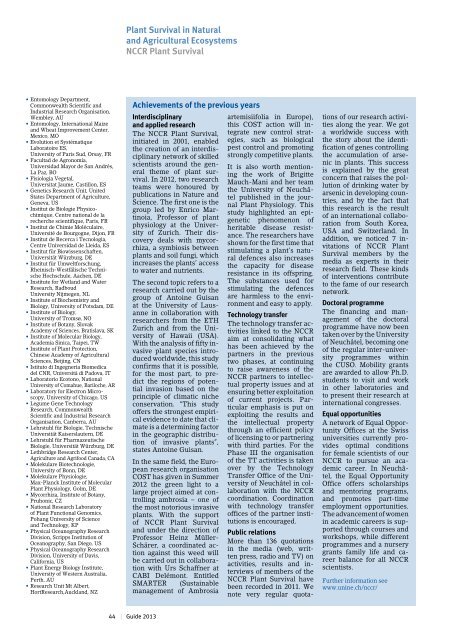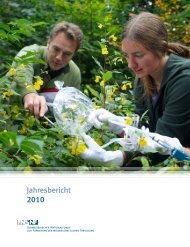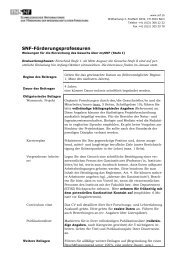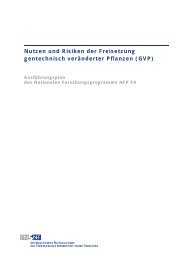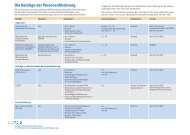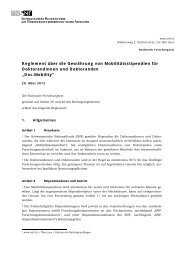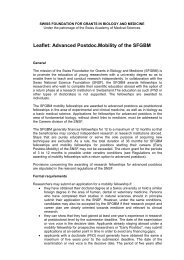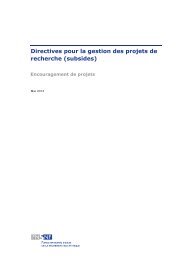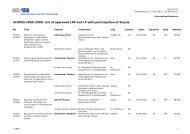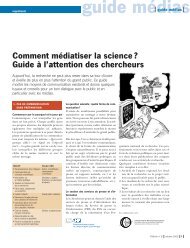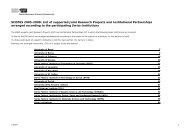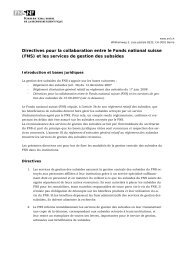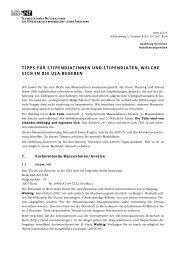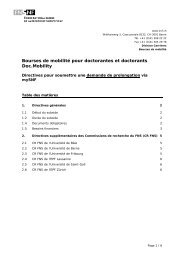NCCR Guide 2013 - Schweizerischer Nationalfonds (SNF)
NCCR Guide 2013 - Schweizerischer Nationalfonds (SNF)
NCCR Guide 2013 - Schweizerischer Nationalfonds (SNF)
You also want an ePaper? Increase the reach of your titles
YUMPU automatically turns print PDFs into web optimized ePapers that Google loves.
Plant Survival in Natural<br />
and Agricultural Ecosystems<br />
<strong>NCCR</strong> Plant Survival<br />
• Entomology Department,<br />
Commonwealth Scientific and<br />
Industrial Research Organisation,<br />
Wembley, AU<br />
• Entomology, International Maize<br />
and Wheat Improvement Center,<br />
Mexico, MO<br />
• Evolution et Systématique<br />
Laboratoire ES,<br />
University of Paris Sud, Orsay, FR<br />
• Facultad de Agronomía,<br />
Universidad Mayor de San Andrés,<br />
La Paz, BO<br />
• Fisiologia Vegetal,<br />
Universitat Jaume, Castillon, ES<br />
• Genetics Research Unit, United<br />
States Department of Agriculture,<br />
Geneva, US<br />
• Institut de Biologie Physicochimique,<br />
Centre national de la<br />
recherche scientifique, Paris, FR<br />
• Institut de Chimie Moléculaire,<br />
Université de Bourgogne, Dijon, FR<br />
• Institut de Recerca i Tecnologia,<br />
Centre Universidad de Lleida, ES<br />
• Institut für Biowissenschaften,<br />
Universität Würzburg, DE<br />
• Institut für Umweltforschung,<br />
Rheinisch-Westfälische Technische<br />
Hochschule, Aachen, DE<br />
• Institute for Wetland and Water<br />
Research, Radboud<br />
University Nijmegen, NL<br />
• Institute of Biochemistry and<br />
Biology, University of Potsdam, DE<br />
• Institute of Biology,<br />
University of Tromsø, NO<br />
• Institute of Botany, Slovak<br />
Academy of Sciences, Bratislava, SK<br />
• Institute of Molecular Biology,<br />
Academia Sinica, Taipei, TW<br />
• Institute of Plant Protection,<br />
Chinese Academy of Agricultural<br />
Sciences, Beijing, CN<br />
• Istituto di Ingegneria Biomedica<br />
del CNR, Università di Padova, IT<br />
• Laboratorio Ecotono, National<br />
University of Comahue, Bariloche, AR<br />
• Laboratory for Electron Microscopy,<br />
University of Chicago, US<br />
• Legume Gene Technology<br />
Research, Commonwealth<br />
Scientific and Industrial Research<br />
Organisation, Canberra, AU<br />
• Lehrstuhl für Biologie, Technische<br />
Universität Kaiserslautern, DE<br />
• Lehrstuhl für Pharmazeutische<br />
Biologie, Universität Würzburg, DE<br />
• Lethbridge Research Center,<br />
Agriculture and Agrifood Canada, CA<br />
• Molekulare Biotechnologie,<br />
University of Bonn, DE<br />
• Molekulare Physiologie,<br />
Max-Planck Institute of Molecular<br />
Plant Physiology, Golm, DE<br />
• Mycorrhiza, Institute of Botany,<br />
Pruhonic, CZ<br />
• National Research Laboratory<br />
of Plant Functional Genomics,<br />
Pohang University of Science<br />
and Technology, KP<br />
• Physical Oceanography Research<br />
Division, Scripps Institution of<br />
Oceanography, San Diego, US<br />
• Physical Oceanography Research<br />
Division, University of Davis,<br />
California, US<br />
• Plant Energy Biology Institute,<br />
University of Western Australia,<br />
Perth, AU<br />
• Research Unit Mt Albert,<br />
HortResearch,Auckland, NZ<br />
Achievements of the previous years<br />
Interdisciplinary<br />
and applied research<br />
The <strong>NCCR</strong> Plant Survival,<br />
initiated in 2001, enabled<br />
the creation of an interdisciplinary<br />
network of skilled<br />
scientists around the general<br />
theme of plant survival.<br />
In 2012, two research<br />
teams were honoured by<br />
publications in Nature and<br />
Science. The first one is the<br />
group led by Enrico Martinoia,<br />
Professor of plant<br />
physiology at the University<br />
of Zurich. Their discovery<br />
deals with mycorrhiza,<br />
a symbiosis between<br />
plants and soil fungi, which<br />
increases the plants’ access<br />
to water and nutrients.<br />
The second topic refers to a<br />
research carried out by the<br />
group of Antoine Guisan<br />
at the University of Lausanne<br />
in collaboration with<br />
researchers from the ETH<br />
Zurich and from the University<br />
of Hawaii (USA).<br />
With the analysis of fifty invasive<br />
plant species introduced<br />
worldwide, this study<br />
confirms that it is possible,<br />
for the most part, to predict<br />
the regions of potential<br />
invasion based on the<br />
principle of climatic niche<br />
conservation. “This study<br />
offers the strongest empirical<br />
evidence to date that climate<br />
is a determining factor<br />
in the geographic distribution<br />
of invasive plants”,<br />
states Antoine Guisan.<br />
In the same field, the European<br />
research organisation<br />
COST has given in Summer<br />
2012 the green light to a<br />
large project aimed at controlling<br />
ambrosia – one of<br />
the most notorious invasive<br />
plants. With the support<br />
of <strong>NCCR</strong> Plant Survival<br />
and under the direction of<br />
Professor Heinz Müller-<br />
Schärer, a coordinated action<br />
against this weed will<br />
be carried out in collaboration<br />
with Urs Schaffner at<br />
CABI Delémont. Entitled<br />
SMARTER (Sustainable<br />
management of Ambrosia<br />
artemisiifolia in Europe),<br />
this COST action will integrate<br />
new control strategies,<br />
such as biological<br />
pest control and promoting<br />
strongly competitive plants.<br />
It is also worth mentioning<br />
the work of Brigitte<br />
Mauch-Mani and her team<br />
the University of Neuchâtel<br />
published in the journal<br />
Plant Physiology. This<br />
study highlighted an epigenetic<br />
phenomenon of<br />
heritable disease resistance.<br />
The researchers have<br />
shown for the first time that<br />
stimulating a plant’s natural<br />
defences also increases<br />
the capacity for disease<br />
resistance in its offspring.<br />
The substances used for<br />
stimulating the defences<br />
are harmless to the environment<br />
and easy to apply.<br />
Technology transfer<br />
The technology transfer activities<br />
linked to the <strong>NCCR</strong><br />
aim at consolidating what<br />
has been achieved by the<br />
partners in the previous<br />
two phases, at continuing<br />
to raise awareness of the<br />
<strong>NCCR</strong> partners to intellectual<br />
property issues and at<br />
ensuring better exploitation<br />
of current projects. Particular<br />
emphasis is put on<br />
exploiting the results and<br />
the intellectual property<br />
through an efficient policy<br />
of licensing to or partnering<br />
with third parties. For the<br />
Phase III the organisation<br />
of the TT activities is taken<br />
over by the Technology<br />
Transfer Office of the University<br />
of Neuchâtel in collaboration<br />
with the <strong>NCCR</strong><br />
coordination. Coordination<br />
with technology transfer<br />
offices of the partner institutions<br />
is encouraged.<br />
Public relations<br />
More than 136 quotations<br />
in the media (web, written<br />
press, radio and TV) on<br />
activities, results and interviews<br />
of members of the<br />
<strong>NCCR</strong> Plant Survival have<br />
been recorded in 2011. We<br />
note very regular quotations<br />
of our research activities<br />
along the year. We got<br />
a worldwide success with<br />
the story about the identification<br />
of genes controlling<br />
the accumulation of arsenic<br />
in plants. This success<br />
is explained by the great<br />
concern that raises the pollution<br />
of drinking water by<br />
arsenic in developing countries,<br />
and by the fact that<br />
this research is the result<br />
of an international collaboration<br />
from South Korea,<br />
USA and Switzerland. In<br />
addition, we noticed 7 invitations<br />
of <strong>NCCR</strong> Plant<br />
Survival members by the<br />
media as experts in their<br />
research field. These kinds<br />
of interventions contribute<br />
to the fame of our research<br />
network.<br />
Doctoral programme<br />
The financing and management<br />
of the doctoral<br />
programme have now been<br />
taken over by the University<br />
of Neuchâtel, becoming one<br />
of the regular inter-university<br />
programmes within<br />
the CUSO. Mobility grants<br />
are awarded to allow Ph.D.<br />
students to visit and work<br />
in other laboratories and<br />
to present their research at<br />
international congresses.<br />
Equal opportunities<br />
A network of Equal Opportunity<br />
Offices at the Swiss<br />
universities currently provides<br />
optimal conditions<br />
for female scientists of our<br />
<strong>NCCR</strong> to pursue an academic<br />
career. In Neuchâtel,<br />
the Equal Opportunity<br />
Office offers scholarships<br />
and mentoring programs,<br />
and promotes part-time<br />
employment opportunities.<br />
The advancement of women<br />
in academic careers is supported<br />
through courses and<br />
workshops, while different<br />
programmes and a nursery<br />
grants family life and career<br />
balance for all <strong>NCCR</strong><br />
scientists.<br />
Further information see<br />
www.unine.ch/nccr/<br />
44 | <strong>Guide</strong> <strong>2013</strong>


